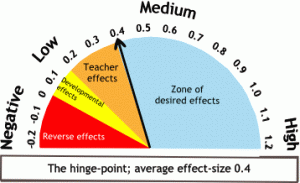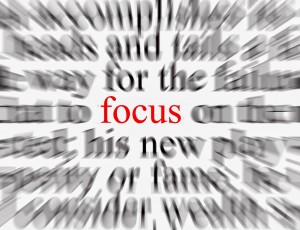This is post number two in a ten part blog series (you may click here to start from the beginning).
This blog series serves to highlight his most significant findings and their applications to our classrooms from John Hattie’s 2012 work, Visible Learning for Teachers: Maximizing Impact on Learning. His work has given educators quantifiable insights that have no parallel in the field of education.
Need an introduction or a crash course on the effect sizes referenced below? An effect size of 0.40 is what Hattie refers to as a hinge-point regarding what is significantly effective or at “a level where the effects of innovation enhance achievement in such a way that we can notice real-world differences” (Hattie, 2009). Anything between a 0.00 and 0.39 is growth, but is not considered significant growth. Anything below a 0.00 is considered detrimental to student growth.
 Number 9 – Teacher Clarity (effect size = 0.75)
Number 9 – Teacher Clarity (effect size = 0.75)
One of Hattie’s most important themes is the importance of teachers effectively communicating the intentions of lessons and what success looks like in relation to these intentions. Hattie cited Fendicks 1990 study on teacher clarity where he defined this principle as “organization, explanation, examples and guided practice, and assessment of student learning.” (2009)
Application to the Classroom
Consider how your use of effectively written learning objectives paired with rubrics that reinforce these expectations play key roles in maximizing your teacher clarity.
In Classroom Instruction That Works by Dean, et. al. (2012), there are four recommendations for setting objectives in the classroom:
- Set learning objectives that are specific but not restrictive.

- Communicate the learning objectives to students and parents.
- Connect the learning objectives to previous and future learning.
- Engage students in setting personal learning objectives.
A fantastic resource for generating standards-aligned rubrics is the website www.themespark.net. This resource provides rubrics in the core teaching areas and art. In addition, rubrics can be customized to meet any subject area.
A Random Mention
Number 113 out of 150 – School Class Size (effect size 0.21)
This is regularly a hot topic found in all places including political debates, teacher contract negotiations, and in discussions around the water cooler. Hattie (2009) asserts that the overall evidence around this topic is not significant in regard to student learning. He cites that “reducing class sizes has not been a powerful moderator on outcomes.” He found that the typical effect size in class size studies of about 0.10-0.20 “could be considered small…and certainly not worth the billions of dollars that is required to reduce the number of children per classroom.”
A Peek at the Bottom 10
Number 149 out of 150 – Home Television (effect size -0.18)
Studies all have slightly different findings, but they all support the idea that once students reach a certain threshold of hours per day spent watching television that a negative effect size emerges. Hattie cites Razel’s 2001 study which found that when students watched more than two hours per day there was a negative effect size. Age, gender, and IQ all had a bearing on the overall impact.
For more from the blog series view the following post:
Hattie, J., Visible Learning: A Synthesis of Over 800 Meta-Analyses Relating to Achievement (2009)
Hattie, J. Visible Learning for Teachers: Maximizing Impact on Learning (2012)
http://visible-learning.org/glossary/#4_Teacher_credibility
Effect size image retrieved from: http://www.learningandteaching.info/teaching/what_works.htm
Focus image retrieved from: http://becomingteachertoday.blogspot.com/2015/04/clarity-in-teaching.html




Leave a Reply